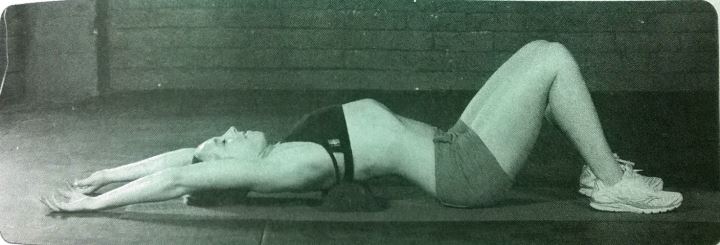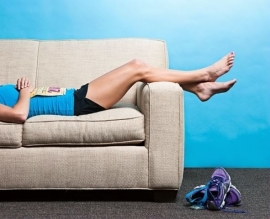游泳选手最常发生的运动伤害部位莫过于肩膀,而训练强度、训练量和距离的上升是受伤的主因。因为肩膀是拥有一个浅篮状凹槽–肩盂腔(glenoid cavity)和球状的肱骨头(humeral head)所组成,被称为肩盂肱骨关节(glenohumeral joint),这个关节的两个结构彼此大小不相配,较大的肱骨总是只有1/3的肩盂所包覆,所以肩关节比实际人体其他关节的活动角度都还来得大,但也因此造成肩膀容易因为重复性的压力而受伤。平均而言,竞赛型的游泳选手一个礼拜大约游6万到8万公尺。以每游25公尺需要划水8到10次来计算,每边肩膀一个礼拜需要转动3万次。虽然此训练量可能比大多数的铁人三项选手还来得多,但若能了解发生在肩膀上有多少次动作,便能帮助我们想像出为何游泳选手那么容易因过度使用肩膀而造成运动伤害。
最常发生于游泳的运动伤害是“肩关节夹挤症候群”,这种症候群通常诊断原因包括:
肩旋转肌肌腱炎 (rotator cuff tendinitis or tendinosis)
滑囊炎( bursitis)
肱二头肌肌腱长头肌腱炎(long head of the biceps tendinitis or tendinosis,
疼痛常出现于手掌过头的动作,像是自由式游泳的入水和抓水的阶段。另外,肩膀受伤的患者在睡觉时也会无法用患侧(茗杰註:例如右肩受伤,便无法倚靠右侧侧睡)。通常,这些伤害的原因是因为自然的生物力学动作,可以藉由修正划水动作模式或是某些运动员的生物力学限制来改善。当治疗这些肩膀伤害时,运动员应该要避免使用划手板或是划桨。
对自由式来说,造成肩膀伤害的原因如下:
提臂入水时超过身体转动的中线
拇指入水
不对称的身体转动
单边换气。
除了按照适当的游泳动作指导,运动选手应该要增强嵴椎活动性和保持良好的旋转轴肌(rotator cuff) 和肩膀的稳定力量。
以下介绍三种对肩膀有帮助的运动可以在游泳前或后来施作。

胸椎伸展上半部滚筒运动
将滚筒垂直放置于你的上背。伸展你的嵴椎和在滚筒上滑动,并且举起你的双手过头。持续1分钟、重复3-5组,每一组泡棉滚筒的滚动位置都可以略微上移。
旋转肌肌力加强
姿势1:将毛巾挤压置于手肘与腰部之间,并且随时保持手肘在90度(茗杰註:可以使用哑铃或是其他有点重量的负重器具)。
姿势2:举起你挤压毛巾的手(茗杰註:量力而为,到自己可以接受的范围即可),并且不要移动肩膀。
最后慢慢放下手回到起始动作
在瑜珈球上作TS动作
把你的臀部和腹部核心肌群放在瑜珈球上,并且将你的双脚放在地板上以维持平衡。注视着地板并且保护你的颈部。让肩膀保持上抬到耳朵的位置,同时使大拇指面对天花板。专注于将你的肩膀靠拢并且触碰在一起。
以上译文与图片摘自:Joe Friel,Jim Vance, editors (2013). Triathlon science.,462, 463, 464. United States of America: Human Kinetics.,下面为原文:
Shoulder Injuries
Shoulder injuries are the most common injury among swimmers, typically resulting from increases in training intensity, volume, and distance. Because the shoulder is a ball-and-socket(glenohumeral) joint with a shallow socket and relatively large ball, it allows tremendous range of motion. This degree of mobility permits the shoulder to perform more movement than virtually any other joint, but it also makes the shoulder prone to breakdown under repeated stress. The average competitive swimmer swims approximately 60,000 to 80,000 meters per week. With a typical count of 8 to 10 strokes per 25-meter lap, each shoulder performs 30,000 rotations each week. Although this training volume may be more than the typical triathlete performs, an understanding of how much movement is occurring in the shoulder is helpful in creating a picturte of why it is so susceptible to overuse injury.
The most common swimming-related injury is describled as impingement syndrome(generlized diagnosis that may include rotator cuff tendinitis or tendinosis, bursitis, long head of the biceps tendinitis or tendinosis, and so on) and presents as pain with overhead activity, pain at water entry or catch phase, and inability to sleep on the affected side.
Typically, these injuries are biomechanical in nature and can be addressed by modifying stroke pattern or in some cases by correcting the athlete’s biomechanical restrictions. When dealing with an injured shoulder the triathlete should avoid the use of paddles and kickboards. Contributors to shoulder injury in the swim stroke are hand entry crossing midline, thumb down entry, asymmetric body roll, and unilateral breathing. Besids obtaining proper swim stroke instuction, the triathlete need to increase spinal mobility and maintain good rotator cuff and scapular stabilizer strength. The following three exercises before or after each swim session can be helpful.
Thoracic Extension Half Foam
Place the foam roll perpendicular to your midback. Extend your spine over the foam roll and lift both arms above your head. Hold for 1 minute and repeat three to five time, moving the foam roller to higher segments of your thoratic spine.
Rotatot Cuff Strengthening
Position 1:Squzzse the towel roll down with the elbow and keep the elbow at 90 degrees at all times. Position 2: Lift your hand while squeezing the towel roll and not moving the shoulder back. Slowly lower back to the starting position.
TS on a Physioball
Place your hips and core onto a physiball and place your feet on the ground for balance. Look at the ground to protect your neck. Keep your shoulders from rising up toward your ears. Concentrate on squeezing your shoulder blades together. Keep your thumbs facing the ceiling.
游泳选手最可能发生的过度运动型伤害在肩膀:
对于游泳选手来说,最大比例的运动伤害部位为肩膀。因为内文中有提到:“一个竞赛型的游泳选手一个礼拜大约游6万到8万公尺。以每游25公尺需要划水8到10次来计算,每边肩膀一周需要转动3万次”。虽然大部分的人一个礼拜的训练量不会到达6万公尺,可是单就游泳自由式这项运动而言,肩膀仍是使用最频繁的部位。
除了译文中介绍的三种辅助运动(胸椎滚桶运动、旋转肌肌力加强和TS动作),我也推荐施作增强肩膀柔软度的动作:请参考youtube上有关使用弹力带增进肩膀柔软度的五个动作示范
因为当我们肩膀柔软度增强时,便能更流畅地作出划水的动作,并且减少肩膀因为动作受限( biomechanical restrictions)而造成的韧带损伤。
最后帮读者们附上游泳选手常见的肩关节运动伤害有:
“肩关节夹击症候群”(shoulder-impingement-syndrome):肩关节夹击症候群的成因是因为肩旋转袖肌群的损伤可能导致肱骨头往上位移,使肩关节的空间变小造成夹击
萤幕截图 2014-10-10 15.12.39
“肩关节滑囊炎”(Bursitis)的简图与简介:反覆的肩膀拉扯或手臂高举过头的动作,会使位于肱骨头的滑囊受压迫与发炎。
萤幕截图 2014-10-10 15.12.53
(摘自DK Publishing:《运动伤害图解圣经》,台北市:旗标,2012,页72)
耐力网LOGO(160象素宽)作者:庄茗杰/编辑:徐国峰
图片来源:Triathlon Science
耐力网相信训练是科学也是艺术,而训练的艺术,是科学化的极致表现。
奥运会马拉松://www.nduoke.com/paobushuju/olympic-games-marathon-results



